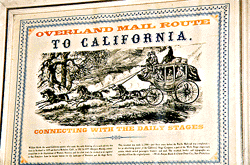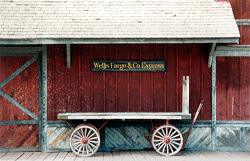Wells Fargo
Updated: August 24, 2020

As miners found their fortunes, they also discovered that more and more they needed dependable banking and transportation services. Gold dust and bullion had to be assayed. The assayer's duties were to test gold for purity, to assign a value to it, then to melt it down into gold bars or coins. Miners needed to ship their gold out to banks, so they depended on stagecoaches to get the job done. Stagecoaches were vital to the lives of early Montanans before the time of the transcontinental railroad.
Some of the first stagecoach services in Montana Territory were provided by Ben Holladay's Overland Mail and Express Company. The company covered over 2,500 miles of roads in the west, including Montana Territory. Ben Holladay was known as the "Stagecoach King." Wells Fargo purchased the stage coach route from Ben Holladay's company in the "Grand Consolidation of 1866." The Wells Fargo company improved the route, until it gained a reputation as one of the best stagecoach routes in the world.
In addition to these well-known companies, several smaller stagecoach companies had local routes in Montana Territory before the "Grand Consolidation." Mail was carried, gold and business paperwork were expressed, and passengers also rode on the stagecoaches. Tickets for passengers were very expensive and cost a small fortune.

A.J. Oliver & Company was the name of the stagecoach line that operated between Virginia City and Bannack. That company also had a route to Salt Lake City, competing with Holladay's service. There were several others: Engell's Prickly Pear, Silver Creek Express, Chamberlain & Thomas, and Charles Smith's Gallatin Express. The stagecoach was not a smooth and easy way to travel. Roads were rough, and people in the stage were often cramped together. Most stage coaches only stopped about once every six to eight hours at small roadside establishments. Most of these roadside stops served beans and biscuits.
In the winter, small metal boxes containing hot coals were the only source of heat in the stagecoach. A few months after Wells Fargo bought out Holladay, there was a terrible snowstorm. As much as ten feet of snow caused the stagecoach from Helena to be stuck in snowdrifts. Of course, there were no snowplows at that time; the roads weren't even paved.
Passengers had to sleep in a stable while they waited for help. It took three days and two nights of slogging through snowdrifts for them to reach a place called Redfern's. They transferred to a sleigh at Redfern's and went on to Virginia City on runners. It was printed up in the Montana Post, Virginia City's newspaper, that the passengers were very excited to get into town.
Later, that January, 1867, it took thirteen days for a stagecoach to get from Salt Lake City to Virginia City, due to snow conditions. Normally, that would have been a six-day journey. The route improved the next winter. Wells Fargo built the White Tail Deer station which could house thirty to forty people on the overnight stop. The trip from Helena to Virginia City had been made into a two-day trip that winter. People would put up with a lot of trouble to make their fortunes in the early gold mines.

It is estimated that approximately four million dollars in gold and gold dust was shipped by stagecoach. About five million dollars is thought to have been shipped out of Montana by steam boat on the Missouri River. Ben Holladay and his partner, W.L. Halsey opened a bank in Virginia City as part of his overland business. Later, in July of 1866, the First National Bank of Helena was opened by Samuel T. Hauser. It became an important banking power in the region.
Before there were assayers in Montana, miners would have to ship their gold as far away as San Francisco to get it ready and poured into gold bars. It wasn't long before assay offices did open up in Montana. In Bannack, J.M. Dunbar opened his office in September of 1866. Also in 1866, Charles Rumley, a Helena jeweler and watch maker expanded his business to assaying. G.S. Neu at Nowland & Weary's Bank and Assay Office was his only competition in Helena, until February of the next year, when the Salt Lake firm called Bohm & Molitor opened their office on Main Street. It was the Bohm & Molitor Company that Wells Fargo recommended.
To promote use of the assay houses, Wells Fargo gave a discount for shipping gold bars and coins, as opposed to shipping raw dust and bullion. Drivers and clerks of Wells Fargo did not have an easy time of it. There were several problems including robberies, Indian attacks, and fires. Sometimes people got frustrated when they did not receive the mail, which was sent on the trains from the East as far as the tracks extended, then picked up by stagecoach. When Wells Fargo bought out most of the major overland mail routes in the West, they were responsible for the U.S. mail. They were also an easy target for blame when the mail was delayed or lost. On the other hand, Wells Fargo was praised for their perseverance in doing business in all kinds of tough conditions. Another particularly bad snowstorm, in 1867, won the company new respect because they continued to get the mail through.

As the railroad moved westward, Wells Fargo accommodated the needs of people by offering a combination stagecoach and railroad ticket package deal. Passengers could buy a ticket from Wells Fargo to a destination in the East that would include both the passage on the stage and on the train, making connections the same way modern modes of transportation do today.
Finally, in 1869, the first transcontinental railroad was completed. This meant that people could travel from the East Coast to the West Coast faster and easier than ever before. This opened up a whole new dimension of interstate commerce and travel. People could ship manufactured goods, household wares and livestock. It was a faster and much more comfortable way to travel than by stagecoach, since the tracks run on a smooth railroad bed instead of bumpy and dusty roads.
Wells Fargo ended their overland service to Montana in 1869, just three years after they had taken it over. During that three years, they had improved the trails, developed their banking services in Montana, and encouraged new growth.
A lot has changed in the past one hundred and forty-odd years, Wells Fargo has changed and grown right along with the times. Today, Wells Fargo continues to be an important banking and investment power. The company operates in several countries around the world.
Updated: August 24, 2020

